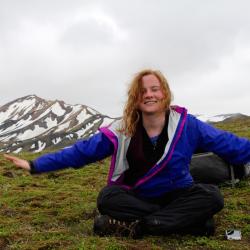Picture this: conversations about women’s frustrations, aspirations, and hesitations flowing across kitchen tables all over the Arctic. Considering Arctic regions are often cut off from one another socially, geographically, and even linguistically, how can these stories be gathered to spark meaningful dialogue? What can these stories tell us about what’s happening and what’s not in terms of gender issues in the Arctic? Moreover, what does gender have to do with Arctic issues?
Rachel Kohut and Tahnee Prior, co-directors of Plan A (genderisnotplanb.com), think they have found a way to start answering these questions. Rachel, a future lawyer primarily interested in health, first met Tahnee, a scholar primarily interested in the environment, at a conference concerning gender and law in 2014. Soon after meeting, they began discussing their experiences working with gender issues in the Arctic. Both agreed that not only is policy in the Arctic lacking a gender component across the board, but that something could be done to fill this chasm in conversation. And thus, a Plan A was born.
Counting on conversation
Through Plan A, a digital storytelling platform intended to gather and share lived experiences of women across the Arctic, Rachel and Tahnee hope that unexplored issues in Arctic research, law, and policy will be identified and addressed. By opening dialogue on being a woman in Arctic regions, Plan A will ideally shed light on what’s missing in Arctic institutions, and allow researchers and policymakers to start filling in these gaps.
“Whether it is women often acting as first responders to shifting landscapes or medevacing long distances in difficult weather to give birth, women across the Arctic have more in common than they might think,” Rachel tells me in an e-mail. She also points to extreme variation in temperature and lengthy distance to healthcare as problems especially common in the colder regions, ones that have particularly drastic consequences for women.
Through this platform, Arctic inhabitants will be the ones shedding light on such issues through lived experiences, bringing policy, law, and academic study closer to those they ultimately affect.
The gender conundrum
Of course, “gender” and what it entails remains up for debate. Plan A will explore these questions within the scope of responses, which ultimately gives participants the ability to determine the course and shape of the ensuing dialogue. For example, whether transgender stories will be included in Plan A depends on whether transgender people choose to participate. And the same goes geographically: the regions included in the discussion will be the regions of those telling their stories.
“We see ourselves as ever changing, guided by the stories shared and voices heard, adapting to what works best for our storytellers. And who are we to cut anyone out of this conversation?” Rachel and Tahnee tell me, stressing that they are working to answer these questions, but don’t plan on answering them alone.
Still, Rachel holds that gender is crucial in discussing Arctic affairs: “So many of the issues affecting the Arctic region, disproportionately affect women, but this often goes overlooked.” Gender, rather than other classifications, is a means of binding stories and people together, as well as a way to focus the wide scope of Arctic issues into an identifiable picture.
The importance of being Iceland
At the core, Iceland’s gender, economic, and environmental issues are somewhat different from those of other Arctic regions. Tahnee notes Iceland’s hefty contributions to international scientific assessments and Arctic policy-making, ultimately highlighting the importance of including gender in these discussions. She argues that because Iceland has such a strong role in these areas, it has strong impact on whether gender is included in these sorts of discussions.
Though Tahnee cites specific gains Iceland has made in incorporating gender into Arctic policy, she also refers to the Centre for Gender Equality Iceland’s 2012 report on “Gender Equality in Iceland.” This report highlights some areas in which women’s economic, political, and social roles have room for improvement. Despite being championed as a utopia of gender equality, Iceland, like other countries in the colder regions, still has steps to take in ensuring gender is considered within the scope of Arctic research, policy, and law.
While allowing for the varying cultural, economic, and environmental needs of Arctic regions, Plan A insists that these needs can be better addressed when examined beside one another. Innovation in Iceland might encourage innovation elsewhere, and vice versa.
Proper attire for a snowstorm
As of now, Plan A consists of a “landing page,” a form in which participants provide their name, contact information, home place, and potential ideas for the site. Plan A has also issued a call for submissions, which can be as short as a 140-character, Tweet-esque composition, and as long as 2,000 words. They can be in a multitude of forms as well, from text to an Instagram post to a series of photos. The deadline for these submissions is listed as “Ongoing”.
Of course, as in all projects, some aspects still need fleshing out. Future Plan A obstacles include finding willing coders to further develop the platform, and deciding how to deal with submissions in languages other than English. Still, with women from Sweden to the Yukon already submitting stories, Rachel and Tahnee remain determined that they can deal with problems as they come. Plan A participants might even provide some solutions themselves.
As for who can take part in this process, Rachel and Tahnee simply ask that those who contribute know the proper attire for a snowstorm. Here in Iceland, that’s certainly one thing locals know how to do, and all too well.
Buy subscriptions, t-shirts and more from our shop right here!
















